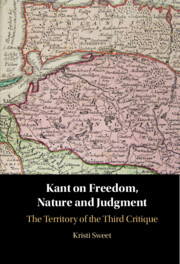Book contents
- Kant on Freedom, Nature, and Judgment
- Kant on Freedom, Nature, and Judgment
- Copyright page
- Dedication
- Epigraph
- Contents
- Acknowledgments
- Abbreviations
- Introduction
- 1 Reason, Hope, and Territory
- 2 Reflection, Purposiveness, Metaphysics
- 3 “Life” and the Ideal of Beauty
- 4 The Sensus Communis and the Ground of the Critical System
- 5 Genius, Aesthetic Ideas, and a Spiritualized Natural Order
- 6 The Domain of Nature as System: Ends
- 7 Hope and Faith: God in the Critique of Teleological Judgment
- Conclusion
- Bibliography
- Index
Interlude: Transition to the Critique of Teleological Judgment
Published online by Cambridge University Press: 07 August 2023
- Kant on Freedom, Nature, and Judgment
- Kant on Freedom, Nature, and Judgment
- Copyright page
- Dedication
- Epigraph
- Contents
- Acknowledgments
- Abbreviations
- Introduction
- 1 Reason, Hope, and Territory
- 2 Reflection, Purposiveness, Metaphysics
- 3 “Life” and the Ideal of Beauty
- 4 The Sensus Communis and the Ground of the Critical System
- 5 Genius, Aesthetic Ideas, and a Spiritualized Natural Order
- 6 The Domain of Nature as System: Ends
- 7 Hope and Faith: God in the Critique of Teleological Judgment
- Conclusion
- Bibliography
- Index
Summary
The most essential difference between the Critique of Aesthetic Judgment and the Critique of Teleological Judgment is the kind of purposiveness they each treat. Both take up the faculty of judgment and its constitutive principle of purposiveness; however, the purpose that constitutes the purposiveness of each half of the text is different. The purposiveness of the Critique of Aesthetic Judgment is a subjective purposiveness, which takes the human subject as its purpose; the purposiveness of the Critique of Teleological Judgment is an objective purposiveness, which focuses on the purpose of objects either in themselves, or with respect to other objects. In the former, what we find out in the territory is judged insofar as it is related to us intimately, to our faculties and also our freedom. In the latter, what we find out in the territory remains exterior to us, and we relate to it in its exteriority, that is, scientifically; it remains objective for us. In teleology, we discover the possibilities we have for conceiving of nature in accord with ends, in individual objects as well as at a systematic level.
- Type
- Chapter
- Information
- Kant on Freedom, Nature, and JudgmentThe Territory of the Third <i>Critique</i>, pp. 154 - 156Publisher: Cambridge University PressPrint publication year: 2023

